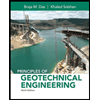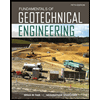
EBK PRINCIPLES OF FOUNDATION ENGINEERIN
8th Edition
ISBN: 9780100547056
Author: Das
Publisher: YUZU
expand_more
expand_more
format_list_bulleted
Concept explainers
Question
error_outline
This textbook solution is under construction.
Students have asked these similar questions
Consider the specifications for an asphaltic concrete mixture and the results of a sieve analysis below.
Coarse aggregates:
Fine aggregates:
Filler:
60%
35%
5%
Percent of Weight of Aggregate or Filler
Passing
Sieve
Designation
Retained on
Sieve
Designation
Coarse
Aggregate
Fine
Aggregate
Mineral
Filler
3/4 in. (19 mm)
1/2 in.
6
1/2 in. (12.5 mm)
3/8 in.
15
3/8 in. (9.5 mm)
No. 4
50
-
No. 4 (4.75 mm)
No. 10
20
1
No. 10 (2 mm)
No. 40 (0.425 mm)
No. 40
9
35
-
No. 80
31
40
No. 80 (0.180 mm)
No. 200 (0.075 mm)
Total
No. 200
-
33
-
-
25
35
100
100
100
Determine the proportion of different aggregates to obtain the required gradation.
Percent of Total Weight of Mixture
Passing
Sieve
Designation
Retained on
Sieve
Designation
Coarse
Aggregate
Fine
Aggregate
3/4 in. (19 mm)
1/2 in. (12.5 mm)
3/8 in. (9.5 mm)
1/2 in.
3/8 in.
No. 4
No. 4 (4.75 mm)
No. 10
No. 10 (2 mm)
No. 40
No. 40 (0.425 mm)
No. 80
No. 80 (0.180 mm)
No. 200
No. 200 (0.075 mm)
Total
Need Help?
Read It
Mineral
Filler
Total
100
Results obtained from laboratory tests on a sample of RC-250 asphalt cement are given. Determine whether the properties of this material meet the Asphalt Institute specifications for this type of material; if not, note the differences. (For each specification, enter the minimum acceptab
value in the same units as used in the test results.)
• Kinematic viscosity at 140°F (60°C) = 230 centistokes
• Flash point (Tagliabue open cup) = 89°F
• Distillation test where distillate percent by volume of total distillate to 680°F (360ºC)
• To 437°F (225°C) = 27%
• To 500°F (260°C) = 69%
• To 600°F (316°C) = 72%
• Residue from distillation to 680°F (360°C) by volume percentage of sample by difference
• Tests on Residue from Distillation:
• Ductility at 77°F (25°C) = 92 cm
• Absolute viscosity at 140°F (60°C) = 620 poises
⚫ Solubility = 90%
Property
Kinematic Viscosity
=
74%
Specification
Test Results
Were Specifications Met?
centistokes
230 centistokes
---Select--- ✓
Flash Point
°F
89°F…
Problem 2
Two machines produce rivets for a factory job. The number of sub-standard rivets per hour by the two
machines are random variables, denoted by X1 and X2. The bivariate PMF of X1 and X2, Px,x,(x1,x2), is
given in the table below.
X2=0
X2=1
X2=2
X2=3
X₁-0
0.07
0.05
0.02
0.01
X₁ =1
0.05
0.16
0.12
0.02
X₁ =2
0.02
0.12
0.17
0.05
X₁ =3
0.01
0.01
0.05
0.07
Knowledge Booster
Learn more about
Need a deep-dive on the concept behind this application? Look no further. Learn more about this topic, civil-engineering and related others by exploring similar questions and additional content below.Similar questions
- please helparrow_forwardAS Q1/ The specific gravity of the soil is 1.41 percentage of water content by weight at field capacity and wilting point are 15% and 7% respectively calculate the equivalent moisture content as equivalent depth for 1.2m root zone : 1. at permanent wilting point 2. at field capacity 3. for ready available waterarrow_forwardQuestion 6 The following figure shows peak-hour volumes for an intersection. Using Webster's method, determine a suitable signal timing for the intersection using the four-phase system shown below. Use an amber interval of 3 seconds and the saturation flow given in the table. O 100 O Phase Lime Group Saturation Flow A e 1615-> 370 3700 B 1615 1615 3700 1615 3700arrow_forward
- PHF-0.91 Pedestrian volume is negligible. Question 7 A parking area with 60 bays has an initial count of 35 vehicles. The in-out survey data for 10-minute intervals is as per the table below. Complete the table, calculate the accumulation, occupancy (%), and parking load (veh.hrs) for each interval. Time (min) In Out Accumulation Occupancy Parking load (%) 0 3 10 2 4 20 1 1 30 1 3 40 1 6 50 1 4 60arrow_forwardQ3/ The following data represent the water depth in the soil of equal areas for specified field. Calculate the uniformity coefficient, efficiency and adequacy of irrigation. Net needed irrigation depth =75 mm (78-04, 79, 88, 85.21, 76,82)arrow_forwardA (A) Q1/ It is required to apply a net depth of 120mm to a total area of 60 ha. The applied discharge is continuously 180 L/s. What must be the time of irrigation? Assume the application efficiency 85%. а Eas 85 0% tarrow_forward
- The following figure is a flexible pavement system with the resilient moduli layer coefficients and drainage coefficients as shown. If the predicted ESAL = 6x106, Reliability, R = 99%, Standard Deviation (So) = 0.45, and APSI = 2.5, select thicknesses D1, D2, and D3 in accordance with the AASHTO Guide for Design of Pavement Structures. E₁ = 400, 000 psi; a₁ = 0.42, Thickness = D₁ E₂=30,000 psi; a₂= 0.14, m₂ = 1.2; Thickness = Dz E=11,000 psi; a=0.08, m3 = 1.2; Thickness = D3 MR= 5,700 psiarrow_forwardDiagramtically show the placement, size, and spacing of temperature steels, dowel bars and tie bars in rigid pavements. Also mention their puproses in rigid pavements.arrow_forwardA six-lane concrete roadway is being designed for a metropolitan area. This roadway will be constructed on a subgrade with an effective modulus of subgrade reaction k of 200 lb/in^3. The ESALs used for the design period is 6.0×10^6. Using the AASHTO design method, determine a suitable thickness of the concrete pavement (to the nearest 1/2 inch), provided that the working stress of the concrete to be used is 600 lb/in^2 and the modulus of elasticity is 6×10^6 lb/in^2. Assume the initial serviceability is 5.0 and the terminal serviceability is 2.0. Assume the overall standard deviation, So, is 0.35, the load transfer coefficient J as 3.2, the drainage coefficient, Cd, is 1.15, and R = 99%.arrow_forward
arrow_back_ios
SEE MORE QUESTIONS
arrow_forward_ios
Recommended textbooks for you
 Principles of Foundation Engineering (MindTap Cou...Civil EngineeringISBN:9781305081550Author:Braja M. DasPublisher:Cengage Learning
Principles of Foundation Engineering (MindTap Cou...Civil EngineeringISBN:9781305081550Author:Braja M. DasPublisher:Cengage Learning Principles of Foundation Engineering (MindTap Cou...Civil EngineeringISBN:9781337705028Author:Braja M. Das, Nagaratnam SivakuganPublisher:Cengage Learning
Principles of Foundation Engineering (MindTap Cou...Civil EngineeringISBN:9781337705028Author:Braja M. Das, Nagaratnam SivakuganPublisher:Cengage Learning Principles of Geotechnical Engineering (MindTap C...Civil EngineeringISBN:9781305970939Author:Braja M. Das, Khaled SobhanPublisher:Cengage Learning
Principles of Geotechnical Engineering (MindTap C...Civil EngineeringISBN:9781305970939Author:Braja M. Das, Khaled SobhanPublisher:Cengage Learning Fundamentals of Geotechnical Engineering (MindTap...Civil EngineeringISBN:9781305635180Author:Braja M. Das, Nagaratnam SivakuganPublisher:Cengage Learning
Fundamentals of Geotechnical Engineering (MindTap...Civil EngineeringISBN:9781305635180Author:Braja M. Das, Nagaratnam SivakuganPublisher:Cengage Learning

Principles of Foundation Engineering (MindTap Cou...
Civil Engineering
ISBN:9781305081550
Author:Braja M. Das
Publisher:Cengage Learning

Principles of Foundation Engineering (MindTap Cou...
Civil Engineering
ISBN:9781337705028
Author:Braja M. Das, Nagaratnam Sivakugan
Publisher:Cengage Learning

Principles of Geotechnical Engineering (MindTap C...
Civil Engineering
ISBN:9781305970939
Author:Braja M. Das, Khaled Sobhan
Publisher:Cengage Learning

Fundamentals of Geotechnical Engineering (MindTap...
Civil Engineering
ISBN:9781305635180
Author:Braja M. Das, Nagaratnam Sivakugan
Publisher:Cengage Learning
How to build angle braces; Author: Country Living With The Harnish's;https://www.youtube.com/watch?v=3cKselS6rxY;License: Standard Youtube License